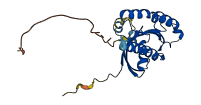Q9LZD4
Gene name |
RABE1D (RAB8C, At5g03520, F12E4.300) |
Protein name |
Ras-related protein RABE1d |
Names |
AtRABE1d, Ras-related protein Rab8C, AtRab8C |
Species |
Arabidopsis thaliana (Mouse-ear cress) |
KEGG Pathway |
ath:AT5G03520 |
EC number |
|
Protein Class |
|

Descriptions
The autoinhibited protein was predicted that may have potential autoinhibitory elements via cis-regPred.
Autoinhibitory domains (AIDs)
Target domain |
|
Relief mechanism |
|
Assay |
cis-regPred |
Accessory elements
No accessory elements
Autoinhibited structure

Activated structure

1 structures for Q9LZD4
| Entry ID | Method | Resolution | Chain | Position | Source |
|---|---|---|---|---|---|
| AF-Q9LZD4-F1 | Predicted | AlphaFoldDB |
2 variants for Q9LZD4
| Variant ID(s) | Position | Change | Description | Diseaes Association | Provenance |
|---|---|---|---|---|---|
| ENSVATH06916035 | 202 | A>P | No | 1000Genomes | |
| ENSVATH06916035 | 202 | A>S | No | 1000Genomes |
No associated diseases with Q9LZD4
3 GO annotations of cellular component
| Name | Definition |
|---|---|
| Golgi membrane | The lipid bilayer surrounding any of the compartments of the Golgi apparatus. |
| intracellular membrane-bounded organelle | Organized structure of distinctive morphology and function, bounded by a single or double lipid bilayer membrane and occurring within the cell. Includes the nucleus, mitochondria, plastids, vacuoles, and vesicles. Excludes the plasma membrane. |
| plasma membrane | The membrane surrounding a cell that separates the cell from its external environment. It consists of a phospholipid bilayer and associated proteins. |
2 GO annotations of molecular function
| Name | Definition |
|---|---|
| GTP binding | Binding to GTP, guanosine triphosphate. |
| GTPase activity | Catalysis of the reaction: GTP + H2O = GDP + H+ + phosphate. |
3 GO annotations of biological process
| Name | Definition |
|---|---|
| protein secretion | The controlled release of proteins from a cell. |
| regulation of exocytosis | Any process that modulates the frequency, rate or extent of exocytosis. |
| vesicle docking involved in exocytosis | The initial attachment of a vesicle membrane to a target membrane, mediated by proteins protruding from the membrane of the vesicle and the target membrane, that contributes to exocytosis. |
29 homologous proteins in AiPD
| UniProt AC | Gene Name | Protein Name | Species | Evidence Code |
|---|---|---|---|---|
| P07560 | SEC4 | Ras-related protein SEC4 | Saccharomyces cerevisiae (strain ATCC 204508 / S288c) (Baker's yeast) | PR |
| Q1RMR4 | RAB15 | Ras-related protein Rab-15 | Bos taurus (Bovine) | PR |
| Q2HJI8 | RAB8B | Ras-related protein Rab-8B | Bos taurus (Bovine) | PR |
| A4FV54 | RAB8A | Ras-related protein Rab-8A | Bos taurus (Bovine) | PR |
| Q5F470 | RAB8A | Ras-related protein Rab-8A | Gallus gallus (Chicken) | PR |
| P61007 | RAB8A | Ras-related protein Rab-8A | Canis lupus familiaris (Dog) (Canis familiaris) | PR |
| P51152 | RAB12 | Ras-related protein Rab-12 | Canis lupus familiaris (Dog) (Canis familiaris) | PR |
| P0C0E4 | RAB40AL | Ras-related protein Rab-40A-like | Homo sapiens (Human) | PR |
| Q12829 | RAB40B | Ras-related protein Rab-40B | Homo sapiens (Human) | PR |
| Q6IQ22 | RAB12 | Ras-related protein Rab-12 | Homo sapiens (Human) | PR |
| Q8WXH6 | RAB40A | Ras-related protein Rab-40A | Homo sapiens (Human) | PR |
| Q92930 | RAB8B | Ras-related protein Rab-8B | Homo sapiens (Human) | PR |
| Q96S21 | RAB40C | Ras-related protein Rab-40C | Homo sapiens (Human) | PR |
| P61006 | RAB8A | Ras-related protein Rab-8A | Homo sapiens (Human) | PR |
| Q8K386 | Rab15 | Ras-related protein Rab-15 | Mus musculus (Mouse) | PR |
| Q8CB87 | Rab44 | Ras-related protein Rab-44 | Mus musculus (Mouse) | PR |
| P35283 | Rab12 | Ras-related protein Rab-12 | Mus musculus (Mouse) | PR |
| P55258 | Rab8a | Ras-related protein Rab-8A | Mus musculus (Mouse) | PR |
| P61028 | Rab8b | Ras-related protein Rab-8B | Mus musculus (Mouse) | PR |
| Q8VHQ4 | Rab40c | Ras-related protein Rab-40C | Mus musculus (Mouse) | PR |
| Q9DD03 | Rab13 | Ras-related protein Rab-13 | Mus musculus (Mouse) | PR |
| Q8VHP8 | Rab40b | Ras-related protein Rab-40B | Mus musculus (Mouse) | PR |
| P35289 | Rab15 | Ras-related protein Rab-15 | Rattus norvegicus (Rat) | PR |
| P35280 | Rab8a | Ras-related protein Rab-8A | Rattus norvegicus (Rat) | PR |
| P35284 | Rab12 | Ras-related protein Rab-12 | Rattus norvegicus (Rat) | PR |
| P70550 | Rab8b | Ras-related protein Rab-8B | Rattus norvegicus (Rat) | PR |
| P35281 | Rab10 | Ras-related protein Rab-10 | Rattus norvegicus (Rat) | PR |
| O24466 | RABE1A | Ras-related protein RABE1a | Arabidopsis thaliana (Mouse-ear cress) | PR |
| Q9SF91 | RABE1E | Ras-related protein RABE1e | Arabidopsis thaliana (Mouse-ear cress) | PR |
| 10 | 20 | 30 | 40 | 50 | 60 |
| MAVAPARARS | DYDYLIKLLL | IGDSGVGKSC | LLLRFSDDTF | TTSFITTIGI | DFKIRTVELD |
| 70 | 80 | 90 | 100 | 110 | 120 |
| GKRIKLQIWD | TAGQERFRTI | TTAYYRGAMG | ILLVYDVTDE | SSFNNIRNWM | KNIEQHASDN |
| 130 | 140 | 150 | 160 | 170 | 180 |
| VNKILVGNKA | DMDESKRAVP | TAKGQALADE | YGIKFFETSA | KTNLNVENVF | MSIAKDIKQR |
| 190 | 200 | 210 | |||
| LTETDTKAEP | QGIKITKQDT | AASSSTAEKS | ACCSYV |